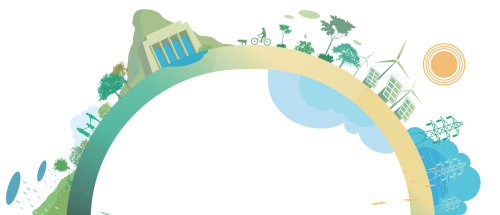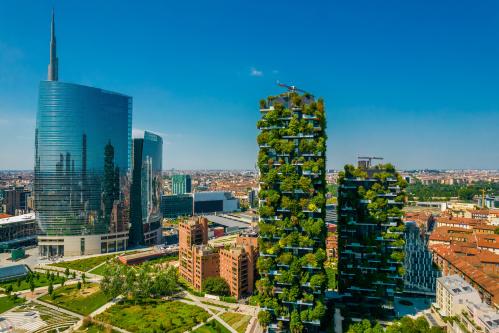In a recent report on the state of the world’s 17 Sustainable Development Goals (SDGs), the U.N. Secretary General did not mince his words: “An urgent rescue effort is needed … to get the SDGs back on track.” Three years into a global pandemic and related social and economic crises, a projected 75-95 million more people are living in extreme poverty, hundreds of millions of children have missed out on critical education, and global energy-related CO2 emissions are on the rise again in a world riddled by violent conflict and deepening geopolitical division.
The SDGs—which embody the world’s foremost economic, social, and environmental ambitions to be achieved by 2030—were no easy fix to begin with. Not because solutions and resources to achieve the SDGs do not exist, but because the SDGs are challenges that must be addressed together. Go-it-alone approaches will not cut it: Technical advances and financing required within each SDG must be coupled with policies and politics that manage tradeoffs across all the goals to ensure that no one is left behind. Getting the SDGs back on track will require nothing short of a global collective effort—by all and for all.
Getting the SDGs back on track will require nothing short of a global collective effort—by all and for all.
Yet, the world’s existing capacities to forge international cooperation, represent citizen interests, and spark new forms of collaboration and innovation for planetary sustainability and societal well-being are clearly not measuring up to the scale and urgency that a rescue effort for the SDGs demands.
A biologist or behavioral scientist might suggest that what’s needed to rescue the SDGs is collective intelligence. Collective intelligence refers to the ability of a system to perform at levels greater than the sum of its individual parts. Ants in a colony, neurons in a nervous system, or musicians in an ensemble produce impressive collective-level feats that no individual ant, neuron, or musician can achieve alone. Intelligent collectives, in turn, provide an environment in which individuals can survive and thrive.
Collective intelligence for the SDGs would require the global system—made up of traditional sovereign-based institutions of international cooperation as well as an increasingly diverse ecosystem of subnational, civil society, and private-sector actors—to perform at levels greater than the sum of its parts to drive progress within each of the 17 SDGs and across all goals at once.
3 ingredients for collective intelligence to achieve the SDGs
Three “ingredients” from the emerging science of human collective intelligence may be useful for policymakers and practitioners who are working to get the SDGs back on track. In brief, action is needed to catalyze collective intelligence, bonding is required to sustain it, and ritual can be used to scale it.
Action
Biological systems have a bias toward action. Living systems act first and learn by doing. Humans are no exception: In sport, when a cricket ball (or baseball) is hit into the air, an intelligent outfielder acts first by moving toward a best guess of where the ball will land, and updates that initial prediction on the run until the catch is made.
There is no shortage of action in the global system, but, unlike a highly trained athlete, global action is not directed intelligently toward global goals.
Built for aligning national interests (not initiating global-scale action), institutions based on national sovereignty—from the U.N., the World Bank, to the IMF—are not moving fast enough on key issues like climate and poverty. Meanwhile, emerging networks of philanthropies, companies, and local community leaders are increasingly demonstrating capacity and flexibility to drive technical breakthroughs like vaccine development, deliver critical services like direct cash transfers, or mobilize new coalitions for a green energy transition. But absent global-level coordination, these actions will likely fall short of global-scale impact needed to achieve the SDGs.
Spurring global-scale action toward the SDGs will require whole-of-society coordination at every scale at which society self-organizes. At the global level, Anne-Marie Slaughter and Gordon LaForge recently proposed using the SDGs to establish “impact hubs” to drive action that integrates the capacities of legacy sovereign-based institutions with those of more flexible civil society and private sector actors. An impact hub for climate action (SDG13) could bring together the U.N. Environment Program with the Global Covenant of Mayors for Climate and Energy to spur new partnerships and programs for green energy or nature-based solutions at the municipal level. In a similar vein, John McArthur has proposed mapping a full range of global multilateral actors and SDG issues as a “matrix” within which cross-functional coalitions can drive action within each SDG and coordinate across all SDGs.
Action to catalyze collective intelligence for the SDGs must be coupled with learning. This means establishing more direct connections between specific SDG actions and standardized metrics of SDG progress. Beyond official national-level review processes for the SDGs, promising examples of efforts to increase the scale and precision of SDG action and learning have emerged, such as the proliferation of unofficial SDG implementation review processes—e.g., “Voluntary Local Reviews” and even “Voluntary University Reviews”—initiated by local leaders. More solutions like these can help fill gaps of geographic coverage, timeliness, and disaggregation, and help support increasingly intelligent action for SDG progress.
Bonding
If action is key to catalyzing collective intelligence, bonding is the glue that sustains it. When individuals act together in families, teams, and communities, they bond—physically, emotionally, and mentally—and more closely bonded collectives perform better together. Bonds give individuals stable and reliable access to the support and intelligence of other individuals. When an entire team or community is bonded, the collective itself becomes a “supermind”—a rich source of support and intelligence that all members of the collective can access.
As the importance of bonding for collective intelligence becomes clearer, there is a growing consensus that new approaches to coordinating SDG action globally must start locally, within bonded teams and communities. As Slaughter has pointed out in earlier work, impact hubs for global-scale action would work best if the basic units of action were diverse yet bonded teams of stakeholders and experts focused on achieving discrete and time-bound tasks. Embedding close-knit teams within a broader network—a “team of teams”—could help foster an optimal balance between strong ties for getting stuff done and weak ties for knowledge-sharing, serendipity, and creativity.
Consistent with this logic, over the past several years the 17 Rooms initiative has been experimenting with ways to catalyze SDG action and bonding within teams and communities at multiple scales. In each 17 Rooms process, participants gather into working groups (or “Rooms,” typically one per SDG) to identify practical next steps that Room members themselves can advance together in 12-18 months. Communities across the globe, from universities to municipalities, nations, and now even entire international regions have been experimenting with 17 Rooms as a way to foster local progress on SDG priorities. By encouraging each Room to focus on collaborative actions that are “big enough to make a difference, but small enough to get done” within a broader process in which all SDG issues get a seat at the table, the long-term aim is to help catalyze and sustain collective intelligence for the SDGs within any community at any scale.
Ritual
Scaling collective intelligence for the SDGs to the global level will require ritual. Across cultures and throughout time, humans have engaged in shared rituals. Many anthropologists view rituals as social technologies for collective intelligence—shared practices and gatherings that promote societal norms and enhance collective function. For example, rituals help publicly recognize and celebrate behaviors that are important for a given culture: Enduring the pain of walking on hot coals is a hard-to-fake signal of commitment to one’s community; daily prayer reinforces connection to the religious group identity. At the same time, rituals provide a shared space to publicly contest or play with social norms (think Mardi Gras or Carnival), helping collectives adapt and change over time.
The Olympics are the best example of a global-scale shared ritual in the modern era. The Olympics recognize and promote the types of individual-level (e.g., dedication, physical mastery, and athleticism) and collective-level (e.g., patriotism and peaceful international exchange) behaviors that facilitate a system of nation-states with competing interests. While not free from controversy and politics, Olympic events are run according to agreed-upon rules and transparent and verifiable metrics for success.
The SDGs need shared rituals to transform SDG actions within bonded communities into broadly recognized norms and practices. Of all national constituencies, Japan is leading the way when it comes to the promotion of shared rituals for the SDGs, with companies, schools, cities, and prefectures all compelled to embrace the SDGs, at least in spirit if not yet in tangible actions.
But the SDGs transcend sovereign-based interests and demand solutions that surpass the capacity of sovereign actors alone. They are global challenges that demand global rituals.
What if a new global Olympiad—an SDG Olympics—could meet this demand by providing a platform for teams to pursue specific time-bound “quests” for impact with each SDG. As key drivers of action and bonding, local communities (e.g., municipalities), could be the representative unit of the SDG Olympics in place of nations. Transparent and verifiable performance metrics could provide the basis for competition between local communities within each SDG and across all goals. If done right, an SDG Olympiad could help elevate frontier SDG actions of high-performing, close-knit teams to the level of shared norms and values for all members of the global collective to aspire to.
For policymakers and practitioners gearing up for an SDG rescue mission, a focus on collective intelligence—meaning strategies that catalyze action, sustain bonding, and foster rituals for the SDGs—may be our best hope to get the SDGs back on track.
The Brookings Institution is committed to quality, independence, and impact.
We are supported by a diverse array of funders. In line with our values and policies, each Brookings publication represents the sole views of its author(s).








Commentary
The SDGs will need action, bonding, and ritual: Lessons from collective intelligence
September 9, 2022